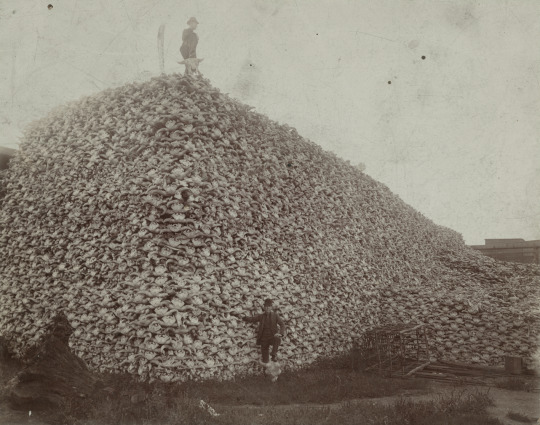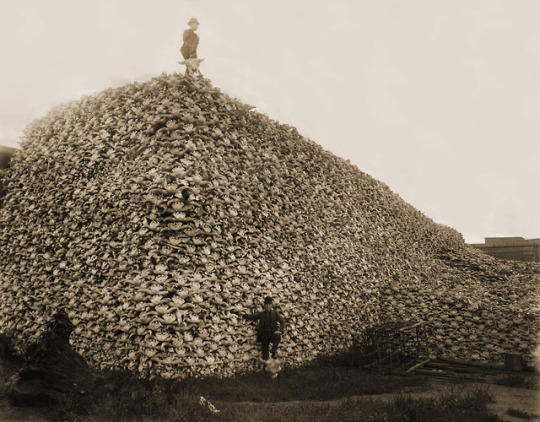#glueworks
Photo

“Man stands on top of enormous pile of buffalo skulls; another man stands in front of pile with his foot resting on a buffalo skull; rustic cage is at foot of pile. Handwritten on back: ‘C.D. 1892 Glueworks, office foot of 1st St., works at Rougeville, Mich.’”
“LD/Industries & business houses-Michigan Carbon Works”
Detroit Public Library - Burton Historical Collection
#buffalo skulls#buffalo#extinction#glue factory#glueworks#rougeville michigan#rougeville mi#1890s#1800s#sepia#vintage#slaughter#death#mass killing#michigan#history#american history#us history#detroit public library#michigan carbon works#ld industries#burton historical collection#skulls#skull mountain#mountain of skulls
3 notes
·
View notes
Text



19th Century gold leaf kain telepok, kain prada; ceremonial shoulder cloth.
Malay people, Palembang, South Sumatra, Indonesia.
Handspun cotton, natural indigo dyes, gold leaf mordant block printing, gluework, batik.
Stothert and Trice
60 notes
·
View notes
Photo

Man stands on top of enormous pile of buffalo skulls; another man stands in front of pile with his foot resting on a buffalo skull; rustic cage is at foot of pile. Handwritten on back: "C.D. 1892 Glueworks, office foot of 1st St., works at Rougeville, Mich."
Detroit Public Library
138 notes
·
View notes
Photo




American bison (also known as just bison, American buffalo, or simply buffalo). One of the World’s most fascinating animals in my opinion. In 9000 BC, the American Bison’s range spanned nearly the entire east half of the North American continent. Once with a population of about 6 million individuals in the late 18th century, the species was hunted to near extinction, with only 541 individuals accounted for in 1889.
The reason for this dramatic decline was a mix of hunting by colonizers and by diseases spread by imported domestic cattle. The American Bison was used as a playing card in the Indian wars in the 19th century, with Europeans hunting the species down as a tactic to torment the Native American populations who greatly depended on the animals for nearly every aspect of living.
Luckily for the species, the 20th century was full of recovery efforts for the animals, and now the population is roughly 31,000. Not nearly the once vast population they once were, but nevertheless, the American Bison was able to evade extinction, which cannot be said about several other animal species affected by human invasion.
Medium: Micron pens on Bristol paper
Technique: Stippling/pointillism
Time: Upwards of 15 hours
Photo reference by the US Forest Service
#bison#american bison#americanbison#buffalo#stippling#illustration#animal art#animal illustration#history#animal history#native american history#conservation#conservation art#species#species recovery#animal conservation#bison conservation#buffalo conservation#american wildlife#american animals
1 note
·
View note
Photo

Enormous pile of bison skulls at 1st St. Glueworks, Rougeville, Michigan, 1892
316 notes
·
View notes
Photo

Pile of American bison skulls waiting to be processed outside glueworks (Detroit, 1892).
10 notes
·
View notes
Note
Alice its gluework jack and u wanted invasive asks so here goes. Whats ur grossest habit? Ill trade u mine
hiiiii jack <3 if i drop food i Will eat it off of the floor
#i won’t defend it because that’s stupid i do it might as well own it#my floors are mostly clean and it strengthens my immune system#now when i was in high school i knew a girl who would eat food off of the BAND ROOM FLOOR where people emptied their spit valves#and that was too far for me#obviously public floors are out of the fucking question#me: i won’t defend it#*defends it*#THANK YOU FOR THE INVASIVE ASK JACK ILY 💕💕#ask#anon
1 note
·
View note
Text

19th Century gold leaf kain telepok, kain prada; ceremonial shoulder cloth. Sumatra.
Handspun cotton, natural indigo dyes, gold leaf mordant block printing, gluework, batik.
Stothert and Trice
13 notes
·
View notes